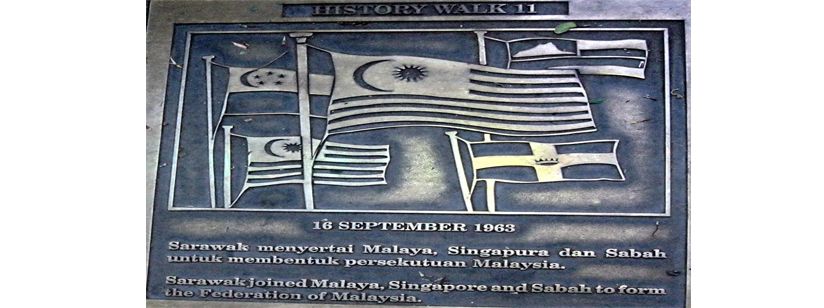KOTA KINABALU : What is "secession"? The current trending word "secession" or "seceding" is derived from the
Latin term
secessio, which describes the act of withdrawing from an organisation, union, or a political entity.
World's history, both in olden days and recent, is astoundingly littered with the act of "seceding". In Americas, Europe, Africa, Indias and even nearby Indonesia the act of seceding has been just too common. Many seceding territories or states did succeed but others were crushed, violently.
While debates seem to be on the rise on suggestions and calls for Sabah and Sarawak states to secede from the Federation of Malaysia (formed in 1963), many, if not all, of those virulently commenting on it online as well as in coffee shops and offices, are actually still ignorant about all things "secession".
This article attempts to enlighten us as to what this word really means and implies to us in Malaysia, in the hope that a politically-enlightened audience would have a healthy discussions and not degenerate the word into a taboo, like some half-baked Malaysian politicians attempted to do.
The majority of the rest of this article is derived from observations records in Wikipedia, now a leading credible online source of reference worldwide.
In his 1991 book Secession:
The Morality of Political Divorce From Fort Sumter to Lithuania and Quebec, philosophy professor
Allen Buchanan outlined limited rights to secession under certain circumstances, mostly related to oppression by people of other ethnic or racial groups, and especially those previously conquered by other peoples.
In 1994 the
Journal of Libertarian Studies published Robert W. McGee's article "Secession Reconsidered". He writes from a
libertarian perspective, but holds that secession is justified only if secessionists can create a viable, if minimal, state on
contiguous territory.
In April 1995 the
Ludwig Von Mises Institute sponsored a secession conference. Papers from the conference were later published in the book
Secession, State and Liberty by David Gordon. Among articles included were: "The Secession Tradition in America" by
Donald Livingston; "The Ethics of Secession" by Scott Boykin; “Nations by Consent: Decomposing the Nation-State” by
Murray Rothbard; "Yankee Confederates: New England Secession Movements Prior to the War Between the States" by
Thomas DiLorenzo; "Was the Union Army's Invasion of the Confederate States a Lawful Act?" by James Ostrowski.
In July 1998 the
Rutgers University journal "Society" published papers from a "Symposium on Secession and Nationalism at the Millennium" including the articles "The Western State as Paradigm" by
Hans-Herman Hoppe, "Profit Motives in Secession" by Sabrina P. Ramet, "Rights of Secession" by Daniel Kofman, "The Very Idea of Secession" by Donald Livingston and "Secession, Autonomy, & Modernity" by Edward A. Tiryakian. In 2007 the
University of South Carolina sponsored a conference called "Secession As an International Phenomenon" which produced a number of papers on the topic.
Justifications for secession
Some theories of secession emphasize a general right of secession for any reason ("Choice Theory") while others emphasize that secession should be considered only to rectify grave injustices ("Just Cause Theory"). Some theories do both.
A list of justifications may be presented supporting the right to secede, as described by Allen Buchanan, Robert McGee, Anthony Birch,
Walter Williams,
Jane Jacobs, Frances Kendall and Leon Louw, Leopold Kohr,
Kirkpatrick Sale, and various authors in David Gordon's "Secession, State and Liberty", includes:
- United States President James Buchanan, Fourth Annual Message to Congress on the State of the Union December 3, 1860: "The fact is that our Union rests upon public opinion, and can never be cemented by the blood of its citizens shed in civil war. If it can not live in the affections of the people, it must one day perish. Congress possesses many means of preserving it by conciliation, but the sword was not placed in their hand to preserve it by force."
- Former President of the United States Thomas Jefferson, in a letter to William H. Crawford, Secretary of War under President James Madison, on June 20, 1816: "In your letter to Fisk, you have fairly stated the alternatives between which we are to choose : 1, licentious commerce and gambling speculations for a few, with eternal war for the many ; or, 2, restricted commerce, peace, and steady occupations for all. If any State in the Union will declare that it prefers separation with the first alternative, to a continuance in union without it, I have no hesitation in saying, 'let us separate'. I would rather the States should withdraw, which are for unlimited commerce and war, and confederate with those alone which are for peace and agriculture."
- Economic enfranchisement of an economically oppressed class that is regionally concentrated within the scope of a larger national territory.
- The right to liberty, freedom of association and private property
- Consent as important democratic principle; will of majority to secede should be recognized
- Making it easier for states to join with others in an experimental union
- Dissolving such union when goals for which it was constituted are not achieved
- Self-defense when larger group presents lethal threat to minority or the government cannot adequately defend an area
- Self-determination of peoples
- Preserving culture, language, etc. from assimilation or destruction by a larger or more powerful group
- Furthering diversity by allowing diverse cultures to keep their identity
- Rectifying past injustices, especially past conquest by a larger power
- Escaping "discriminatory redistribution", i.e., tax schemes, regulatory policies, economic programs, etc. that distribute resources away to another area, especially in an undemocratic fashion
- Enhanced efficiency when the state or empire becomes too large to administer efficiently
- Preserving "liberal purity" (or "conservative purity") by allowing less (or more) liberal regions to secede
- Providing superior constitutional systems which allow flexibility of secession
- Keeping political entities small and human scale through right to secession
Aleksandar Pavkovic, associate professor at the Department of Politics and International Studies at
Macquarie University in Australia and the author of several books on secession describes five justifications for a general right of secession within liberal political theory,
- Anarcho-Capitalism: individual liberty to form political associations and private property rights together justify right to secede and to create a "viable political order" with like-minded individuals.
- Democratic Secessionism: the right of secession, as a variant of the right of self-determination, is vested in a "territorial community" which wishes to secede from "their existing political community"; the group wishing to secede then proceeds to delimit "its" territory by the majority.
- Communitarian Secessionism: any group with a particular "participation-enhancing" identity, concentrated in a particular territory, which desires to improve its members' political participation has a prima facie right to secede.
- Cultural Secessionism: any group which was previously in a minority has a right to protect and develop its own culture and distinct national identity through seceding into an independent state.
- The Secessionism of Threatened Cultures: if a minority culture is threatened within a state that has a majority culture, the minority needs a right to form a state of its own which would protect its culture.
Types of secession
Secession theorists have described a number of ways in which a political entity (city, county, canton, state) can secede from the larger or original state:
- Secession from federation or confederation (political entities with substantial reserved powers which have agreed to join together) versus secession from a unitary state (a state governed as a single unit with few powers reserved to sub-units)
- Colonial aka "wars of independence" from a "mother country" or imperial state
- National (seceding entirely from the national state) versus local (seceding from one entity of the national state into another entity of the same state)
- Central or enclave (seceding entity is completely surrounded by the original state) versus peripheral (along a border of the original state)
- Secession by contiguous units versus secession by non-contiguous units (exclaves)
- Separation or partition (although an entity secedes, the rest of the state retains its structure) versus dissolution (all political entities dissolve their ties and create several new states)
- Irredentism where secession is sought in order to annex the territory to another state because of common ethnicity or prior historical links
- Minority (a minority of the population or territory secedes) versus majority (a majority of the population or territory secedes)
- Secession of better off regions versus secession of worse off regions
- The threat of Secession sometimes is used as a strategy to gain greater autonomy within the original state
Arguments against secession
Allen Buchanan, who supports secession under limited circumstances, lists arguments that might be used against secession
- "Protecting Legitimate Expectations" of those who now occupy territory claimed by secessionists, even in cases where that land was stolen
- "Self Defense" if losing part of the state would make it difficult to defend the rest of it
- "Protecting Majority Rule" and the principle that minorities must abide by them
- "Minimization of Strategic Bargaining" by making it difficult to secede, such as by imposing an exit tax
- "Soft Paternalism" because secession will be bad for secessionists or others
- "Threat of Anarchy" because smaller and smaller entities may choose to secede until there is chaos, although this is not the true meaning of the political and philosophical concept.
- "Preventing Wrongful Taking" such as the state's previous investment in infrastructure
- "Distributive Justice" arguments that wealthier areas cannot secede from poorer ones
Movements that work towards political secession may describe themselves as being autonomy, separatist, independence, self-determination, partition, devolution decentralisation, sovereignty, self-governance or decolonisation movements instead of, or in addition to, being secession movements.
Now let us look at some of the examples of secession movements in as many countries in different continents, just to convince ourselves it is a world's norm to have seen as many secessions, many were successful, some crushed, and yet others just a lingering aspirations or potentialities.
I bet many in Malaysia did not realise that the small enclave nation of now Belgium actually seceded from the Netherlands, and that Portugal seceded from a Kingdom of Spain. Neither do we so realise for sure before that Bangladesh actually seceded from what was formerly East Pakistan, only in the 1970s. Let us read on the list below...
Australia
During the 19th century, the single
British colony in eastern mainland Australia,
New South Wales (NSW) was progressively divided up by the British government as new settlements were formed and spread.
Victoria (Vic) in 1851 and Queensland (Qld) in 1859.
However, settlers agitated to divide the colonies throughout the later part of the century; particularly in
central Queensland (centred in
Rockhampton) in the 1860s and 1890s, and in
North Queensland (with Bowen as a potential colonial capital) in the 1870s. Other secession (or territorial separation) movements arose and these advocated the secession of New England in northern central New South Wales,
Deniliquin in the
Riverina district also in NSW, and
Mount Gambier in the eastern part of
South Australia.
The Principality of Hutt River claims to have seceded from Australia in 1970, although its status is not recognised by Australia or any other country. According to a lexicon on nationalist movements across the world, Macau happened to recognise that Principality.
Austria
Austria successfully seceded from
Nazi Germany on April 27, 1945. This took place after seven years of Austria being part of Adolf Hitler's
Third Reich due to the
Anschluss annexation of Austria into Nazi Germany in March 1938.
Belgium and the Netherlands
On August 25, 1830, during the reign of
William I, the nationalistic opera
La muette de Portici was performed in
Brussels. Soon after, the Belgian Revolt occurred, which resulted in the Belgian secession from the Netherlands.
Brazil
Two southern republican states seceded from Brazil in 1835. Defeated in the
Ragamuffin War, they returned in 1845. The slightly earlier
cabanagem struggle of
Grão-Pará was in part a northern secessionist movement.
Canada
Throughout Canada's history, there has been tension between English-speaking and French-speaking Canadians. Under the
Constitutional Act of 1791, the Quebec colony (including parts of what is today Quebec, Ontario and Newfoundland and Labrador) was divided in two:
Lower Canada (which retained French law and institutions and is now divided between the provinces of
Quebec and
Newfoundland and Labrador) and
Upper Canada (a new colony intended to accommodate the many English-speaking settlers, including the
United Empire Loyalists, and now part of
Ontario). The intent was to provide each group with its own colony. In 1841, the two Canadas were merged into the
Province of Canada. The union proved contentious, however, resulting in a legislative deadlock between English and French legislators. The difficulties of the union led to the adoption of a
federal system in Canada, and the
Canadian Confederation in 1867. The federal framework did not eliminate all tensions, however, leading to the
Quebec sovereignty movement in the latter half of the 20th century.
Central America
China
The
Republic of China (ROC) government, which ruled mainland China from 1911 to 1949, administers Taiwan and a few surrounding islands, while the People's Republic of China (PRC) government administers mainland China. Both sides officially claim sovereignty over both mainland China and Taiwan. There is debate in
Taiwan as to whether to create a new
Republic of Taiwan to replace the current ROC government. At the Third session of the Tenth National People's Congress (March 14, 2005) the PRC government adopted the
Anti-Secession Law of the People's Republic of China. See Taiwan independence.
Congo
Cyprus
In 1974, the Turkish Army invaded northern
Cyprus to protect the interests of the ethnic Turkish minority, who in the following year formed the Turkish Federative State of Cyprus and in 1983 declared independence as the Republic of
Northern Cyprus, recognized only by Turkey.
East Timor
Ethiopia
Following the 1993 victory of opposition forces against the communist
Derg regime during the
Ethiopian Civil War,
Eritrea (formerly known as "Bahri Negash" before being renamed to "Eritrea" by Italian colonizers from 1890–1941) seceded in a United Nations referendum with the blessing of the newly formed Ethiopian government.
European Union
Before the Treaty of Lisbon entered into force on 1 December 2009 no provision in the treaties or law of the European Union outlined the ability of a state to voluntarily withdraw from the EU. The European Constitution did propose such a provision and, after the failure to ratify the Treaty establishing a Constitution for Europe, that provision was then included in the Lisbon Treaty.
The treaty introduces an exit clause for members who wish to withdraw from the Union. This formalises the procedure by stating that a member state may notify the European Council that it wishes to withdraw, upon which withdrawal negotiations begin; if no other agreement is reached the treaty ceases to apply to the withdrawing state two years after such notification.
Gran Colombia
Republic of India
Pakistan seceded from the British Indian empire in what is known as the so-called
the Partition. Today, the
Constitution of India does not allow Indian states to secede from the Union. The disputed occupied territory of Indian-administered Kashmir has had a violent nationalist movement against Indian annexation mostly in the Valley of Kashmir since 1989, which continues and is supported by Pakistan. Other violent secessionist movements in
Nagaland,
Assam,
Manipur,
Punjab (known as the
Khalistan movement),
Mizoram and
Tripura were also formerly active, while
Tamil Nadu had a
non-violent movement in the 1960s. While a violent Maoist insurgency continues to rage across a wide-swath of eastern rural India, the movement is not considered a secessionist movement because the goal of the Maoists is to overthrow the government of India, although rebel commanders have occasionally called for a Communist republic to be carved out of swaths of India. The Pakistani Armed organizations is a participant in the Kashmir conflict and strives to establish the merger state of Jammu and Kashmir from secular India to Muslim Pakistan.
Italy
Iran
Malaysia
When racial and p
artisan strife erupted,
Singapore was expelled from the Malaysian federation in 1965. Agitation for secession has since been sporadic on the culturally distinct large island of
Borneo in the states of
Sabah and
Sarawak although these sentiments has been gaining momentum and supports in the past few years following the proliferation of social medias and failure of the central government to fulfill conditions of the Malaysia Agreement 1963
*Sabah Sarawak Keluar Malaysia - Sabah Sarawak Union (UK), Sarawak Sovereignity Movement (SSM), Sabah Freedom Movement (SFM), Borneo's Plight in Malaysia (BOPIM), Sarawak People's Aspiration (SAPA), Borneo Youth Revolution (BYR), Semangat Satu Perjuangan Rakyat (SSPR), United Borneo Front (UBF)*
Mexico
New Zealand
The
NZ South Island Party with a pro-South agenda, fielded only five candidates (4.2% of electoral seats) candidates in the
1999 General Election but only achieved 0.14% (2622 votes) of the general vote. The reality today is that although "South Islanders" are most proud of their geographic region, secession does not carry any real constituency; the party was not able to field any candidates in the 2008 election due to being unable to enlist 500 paying members, a requirement by the New Zealand Electoral commission. The party is treated more as a "joke" party than any real political force.
Nigeria
Between 1967 and 1970, the unrecognised state of Biafra (The
Republic of Biafra) seceded from Nigeria, resulting in a civil war that ended with the state returning to Nigeria. Later in 1999 at the beginning of a new democratic regime, other secessionist movements emerged, the movement for the Actualization of a Sovereign state of Biafra was formed as a military wing of the Republic of Biafra.
Norway and Sweden
Sweden, having left the
Kalmar Union with Denmark and Norway in the 16th century, entered into a loose
personal union with Norway in 1814. Following a
constitutional crisis, on June 7, 1905 the
Norwegian Parliament declared that King Oscar II had failed to fulfill his constitutional duties. He was therefore no longer King of Norway and because the union depended on the two countries sharing a king, it was thus dissolved. After negotiations Sweden agreed to this on October 26 and on April 14
Pakistan
After the
Awami League won the 1970 national elections, negotiations to form a new government floundered, resulting in the
Bangladesh Liberation War by which the eastern wing of
Pakistan seceded, to become
Bangladesh. The Balochistan Liberation Army (also Baloch Liberation Army or Boluchistan Liberation army) (BLA) is a
Baloch nationalist militant secessionist organization. The stated goals of the organization include the establishment of an independent state of Balochistan free of
Pakistani and
Iranian Federations. The name Baloch Liberation Army first became public in summer 2000, after the organization claimed credit for a series of bomb attacks in markets and removal of railways lines.
Papua New Guinea
Somalia
Soviet Union
South Africa
In 1910, following the British Empire's defeat of the Afrikaner in the
Boer Wars, four self-governing colonies in the south of Africa were merged into the
Union of South Africa. The four regions were the
Cape Colony,
Orange Free State,
Natal and
Transvaal. Three other territories,
High Commission Territories of Bechuanaland (now
Botswana),
Basutoland (now
Lesotho) and
Swaziland later became independent states in the 1960s. Following the election of the
Nationalist government in 1948, some
English-speaking whites in Natal advocated either secession or a loose federation. There were also calls for secession, with Natal and the eastern part of the
Cape Province breaking away. following the
referendum in 1960 on establishing a
republic, and in 1993, prior to South Africa's first elections under universal suffrage and the end of apartheid, some Zulu leaders in
KwaZulu-Natal considered secession as did some politicians in the Cape Province.
In 2008, a political movement calling for the return to independence of the Cape resurged in the shape of the political organisation, the Cape Party. The
Cape Party contested their first elections on 22 April 2009.
Spain
Sri Lanka
Switzerland
United Kingdom
Some of the more radical members of the British
direct democracy movement in the Conservative Party (
Daniel Hannan for example) – while not actually advocating secession – support the federalization of the UK into states along county boundaries (actually a proposal of 5 or 6 regions of England, 4 or 5 in
Scotland and 3 in
Wales). There are currently 9 government office regions in England and none in the other Home Nations.
United States
Discussions and threats of secession often surface in American politics, and secession was declared during the Civil War between the States. However in 1869 the United States Supreme Court ruled in
Texas v. White, 74 U.S. 700 (1869) that unilateral secession was not permitted saying that the union between a state (Texas in the case before the bar) "was as complete, as perpetual, and as indissoluble as the union between the original States. There was no place for reconsideration or revocation, except through revolution or through consent of the States."
Yemen
North Yemen and
South Yemen merged in 1990; tensions led to a 1994 southern secession which was crushed in a civil war.
Yugoslavia
Kosovo declared de facto independence on February 17, 2008, and was recognized by several dozen countries, but officially remains under
United Nations administration.
Source:
http://www.borneoherald.com/2014/02/read-facts-about-secession.html#more



























































